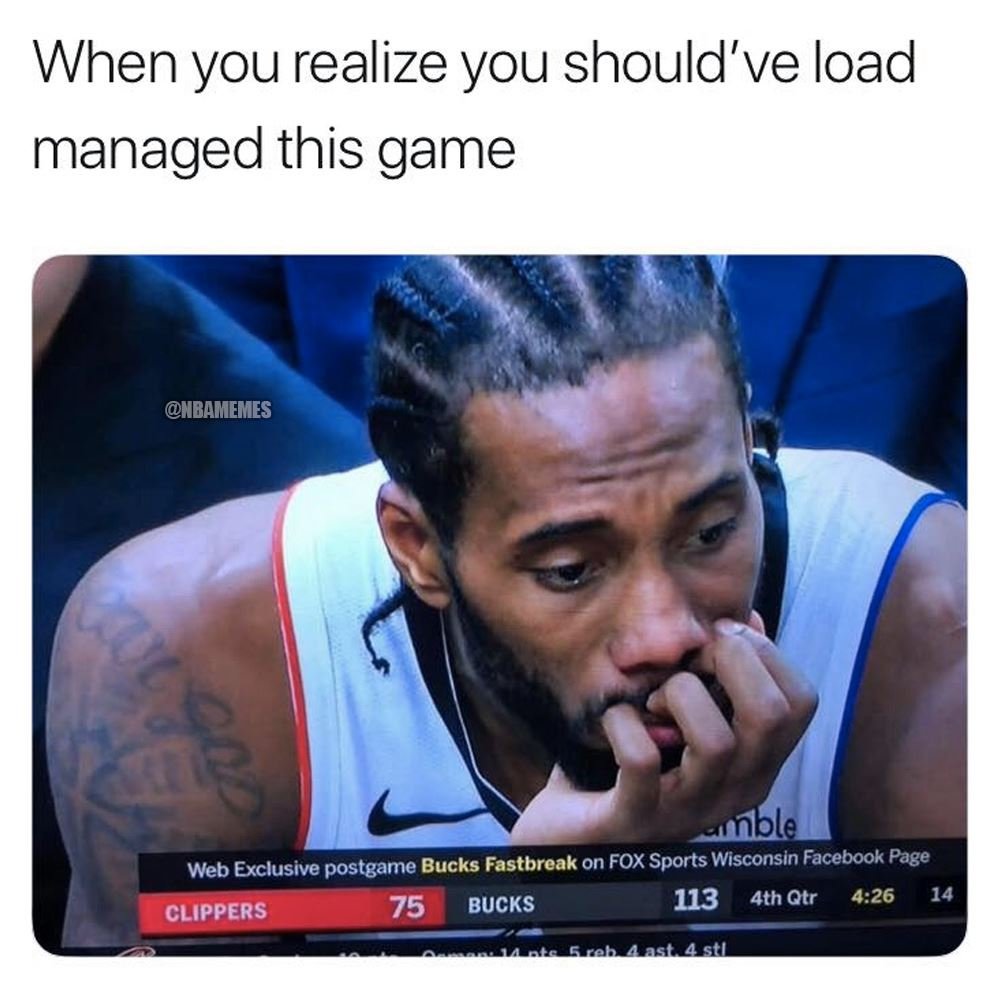Load Management, the NBA, and why every athlete needs to know about it
Kawhi Leonard NBA meme
Is load management a myth that gives NBA stars time to kick back and relax?
Or is the NBA’s 82-game in-season schedule too harsh and demanding for players’ bodies to handle?
Let’s break down some facts and add some science to help YOU understand load management!
What is Load Management?
Load management is a term used in the health and fitness industry to deliberately structure and reduce training and competition with the intention to facilitate global overall improvements in wellness and performance for an athlete. Basically, it is the process of reducing the number of stressors on the athlete’s body from training and competition to help them recover and perform better in the long term.
“Load management is...when you reduce the amount of stressors on the athlete’s body from training and competition to help them recover and perform better in the long term.”
There are two types of loads - External load and Internal load:
External load - the amount of training and/or competition an athlete takes on in a given period of time.
This includes the intensity, volume, and frequency of training.Internal load - the level of effort an athlete exerts during a given session and is what the athlete perceives as “work” or “stress.” Internal load is affected by both physiological factors (e.g., heart rate) and psychological factors (e.g., motivation) (Halson 2014).
https://www.instagram.com/ptcperformance
NBA players’ schedule and correlations of injuries
The NBA has 82 games, with the average NBA player playing 3.5 games per week during the regular season. Travel between cities and states can get as far as 40 000 miles (64373.76km) within one season. Now imagine the stress of paparazzi and media dissecting your every move both on and off the court! We haven't even added the physical demand of competing at the highest level!
“But they fly first class on private jets,” you might retort. "They have millions of dollars to hire people to help them feel 100%," you might argue. Let me say that I agree with you, they do both but let's entertain the idea of changing the structure of NBA games played and see what happens.
*Example of bubble then regular season and number of significant injuries
https://runrepeat.com/nba-bubble-injuries
Lebron’s tweet about the bubble and injuries
From all this, it is clear that when loads are high for consistent periods of time without having periods where bodies can rest and recover, injuries will inevitably occur.
How does this help me as an athlete?
Research shows load changes of more than 15 % from the week before can increase the risk of injury by close to 50% (Gabbett, 2016)
When an athlete appropriately decreases training volume, the result is higher quality workouts. This in turn leads to better movement patterns, less fatigue and ultimately improved performance in the long term. Proper planning and structure of workouts, helps athletes peak when it really matters - at competition time! In the fitness industry, it's called periodisation.
How can you use Load Management in your training?
One way to measure internal load is by using RPE (rate of perceived exertion) (Inoue et al. 2022).
RPE is a subjective measure of how hard an athlete feels they are working on a scale from 1-10, with 1 being very light and 10 being maximal effort. In order to properly use RPE to manage internal load, it is important to understand what each number on the scale represents.
Below is a chart that can be used as a reference.
Tracking external load is much easier, especially with a structured program. The internet has many different structured programs available.
A program that I have personally tried and thought very highly of is:
PJF Performance’s Vert Code or Vert Code Elite
It is well designed, follows the principles of progressive overload and can be done without equipment (Vert Code) or with equipment (Vert Code Elite).
To be more effective and optimal in your training, it is always recommended to have an individualised program as it tailors to your lifestyle, and goals, considers your current level of capacity and helps you to build from there.
Check out our sports performance sessions where we can help you build a program to get faster, stronger and jump higher!
Take homes
Being a professional athlete and competing regularly will stress the body. It’s clearly seen that changes in competition structure, like during the NBA bubble and the season after that, increases the overall load on their athletes and therefore can influence the rate of serious injuries.
Understanding this as an athlete, and not always pushing yourself to the nth degree, will in the long term provide better performance. In other words, train hard and smart, not just hard.
If you want help incorporating load management into your routine, don’t hesitate to reach out to us here at PTC Performance.
With our team, we can help make sure you stay healthy and perform at your best!
Bibliography
Gabbett, TJ 2016, ‘The Training—Injury Prevention Paradox: Should athletes be training smarter and harder?’, British Journal of Sports Medicine, vol. 50, no. 5, pp. 273–280.
Halson, SL 2014, ‘Monitoring Training Load to Understand Fatigue in Athletes’, Sports Medicine, vol. 44, no. S2, pp. 139–147.
Inoue, A, dos Santos Bunn, P, do Carmo, EC, Lattari, E & da Silva, EB 2022, ‘Internal Training Load Perceived by Athletes and Planned by Coaches: A Systematic Review and Meta-Analysis’, Sports Medicine - Open, vol. 8, no. 1.





